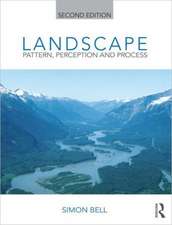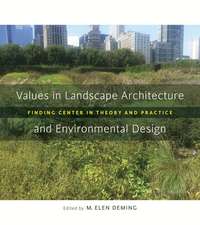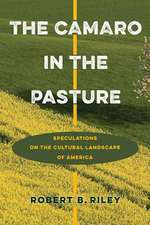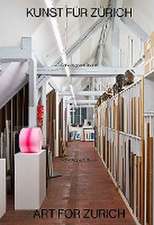The Landscapes of Dieter Kienast
Autor Anette Freytag Prefață de Erik A. De Jong Cuvânt înainte de Christophe Girot Fotograf Georg Aernien Limba Engleză Paperback – 15 iun 2021
Preț: 501.24 lei
Preț vechi: 589.69 lei
-15% Nou
Puncte Express: 752
Preț estimativ în valută:
95.92€ • 99.54$ • 80.18£
95.92€ • 99.54$ • 80.18£
Carte disponibilă
Livrare economică 20-26 februarie
Livrare express 08-14 februarie pentru 54.81 lei
Preluare comenzi: 021 569.72.76
Specificații
ISBN-13: 9783856763879
ISBN-10: 3856763872
Pagini: 440
Ilustrații: 150 color plates, 110 halftones
Dimensiuni: 229 x 311 x 28 mm
Greutate: 1.36 kg
Editura: gta publishers
Colecția gta publishers
ISBN-10: 3856763872
Pagini: 440
Ilustrații: 150 color plates, 110 halftones
Dimensiuni: 229 x 311 x 28 mm
Greutate: 1.36 kg
Editura: gta publishers
Colecția gta publishers
Notă biografică
Anette Freytag is a professor of landscape architecture at Rutgers University.
Cuprins
I The Nature of the City
Traces of Kassel
A New Type of Green Urban Planner
A New Theory of Planning Open Spaces: The Kassel School
Lucius Burckhardt’s Critique of Planning
Kienast and the Kassel School
The Third Stocktaking of the World
The Natural and the Artificial:
The Dry Grassland Biotope in Basel
Sociopolitical Allegories
Vegetation and Use: The École cantonale de langue française in Bern
New Images of Urban Nature
Processes of Reinterpretation:
The Front Yard and Rear Courtyardfor Ernst Basler + Partner in Zurich
Conditions for Designing Urban Open
Space: The Garden Courtyard for the Schweizerische Rückversicherungs-Gesellschaft in Zurich
II Forms of Use
Aesthetic Experience and Coping with Everyday Life
“Using Open Space Means Coping with Everyday Life”: Kienast’s First Design for
the Grounds of a Housing Development
Form as the Antithesis of the Natural Garden: The Brühlwiese Municipal Park
in Wettingen
Transparency and Collage: Making City and Countryside Legible
One’s Own Garden as a Field for Experiment
Mourning and the Experience of Nature: Consolation through Beauty as a Way of
Coping with Everyday Life
III Drawing and Perceiving Media of Representation
From Zoning to Designing
“This Thing We Call Art”: Dieter Kienast and the Phenomenology of Postmodernism: Art, Architecture, Literature
A Vocabulary for the Landscape I: haping the Terrain
A Vocabulary for the Landscape II: Drawing and Representation as Processes
for Understanding Topography, Form, and Material
Mechanisms of Representation: Texts,Photographs, Exhibitions, and Video
Traces of Kassel
A New Type of Green Urban Planner
A New Theory of Planning Open Spaces: The Kassel School
Lucius Burckhardt’s Critique of Planning
Kienast and the Kassel School
The Third Stocktaking of the World
The Natural and the Artificial:
The Dry Grassland Biotope in Basel
Sociopolitical Allegories
Vegetation and Use: The École cantonale de langue française in Bern
New Images of Urban Nature
Processes of Reinterpretation:
The Front Yard and Rear Courtyardfor Ernst Basler + Partner in Zurich
Conditions for Designing Urban Open
Space: The Garden Courtyard for the Schweizerische Rückversicherungs-Gesellschaft in Zurich
II Forms of Use
Aesthetic Experience and Coping with Everyday Life
“Using Open Space Means Coping with Everyday Life”: Kienast’s First Design for
the Grounds of a Housing Development
Form as the Antithesis of the Natural Garden: The Brühlwiese Municipal Park
in Wettingen
Transparency and Collage: Making City and Countryside Legible
One’s Own Garden as a Field for Experiment
Mourning and the Experience of Nature: Consolation through Beauty as a Way of
Coping with Everyday Life
III Drawing and Perceiving Media of Representation
From Zoning to Designing
“This Thing We Call Art”: Dieter Kienast and the Phenomenology of Postmodernism: Art, Architecture, Literature
A Vocabulary for the Landscape I: haping the Terrain
A Vocabulary for the Landscape II: Drawing and Representation as Processes
for Understanding Topography, Form, and Material
Mechanisms of Representation: Texts,Photographs, Exhibitions, and Video
Recenzii
2022 Receipient
Recipient of the 2022 Landscape Studies Initiative Book Award
















